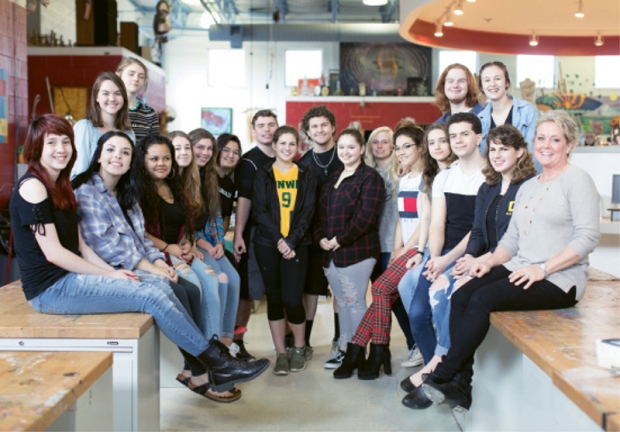AAST art program provides ideal environment for creative vision

How does one grow a professional artist? It not only takes creativity and innovation but resources, commitment, discipline and cooperation.
And it takes only one step into the art studio at Horry County Schools’ Academy for the Arts, Science and Technology (AAST) to know that this program offers students the rich, nurturing environment necessary to cultivate a promising artistic identity.
Surfboards, mannequins, coat hangers and musical instruments crafted into 3D pieces share wall and floor space with sculpture, pottery, paintings and drawings. Materials are scattered throughout cubbies and desks amidst students sharply focused on their work. They stare, lean back and gaze, scrutinize, reshape and select another brush, wire or pen. Others consult their peers, asking for a look or feedback on an idea. Media is limitless here in the AAST studio, and students are encouraged to push the edges of their imagination to consider new ways of conceptualizing and producing art.
“My senior mastery project is the exploration of the movement of people and animals through wire,” says senior Kirsten Bush. “I take a basic structure, and then I layer wire over and over to get the forms I want.” Currently, she’s forming a ballerina, which will be one of a number of figures mounted on a half crescent of aluminum wire. “I’m kind of borrowing techniques from two wire artists, Richard Stainthorp and Seung Mo Park.”
Meanwhile, senior Kyle Blandford, who won third place last year at the Franklin G. Burroughs-Simeon B. Chapin Art Museum’s annual high school juried exhibition for a 3D sculpture, has now turned his sights to painting.
“I’m doing expressionist portraiture,” Blandford says. “I find the emotional intensity and values behind a piece stick out more, make it more memorable, if you can find something that you can resonate or connect with.”
AAST art majors are selected to enter the honors program as juniors. Of the 25 new majors each year, some are already enrolled at AAST and others transfer from their base high schools. After a broad range of coursework and experimentation in both traditional and new forms of media during their junior year, students complete the Senior Exhibition of Mastery. This yearlong endeavor involves production of two bodies of work, each comprised of 12 pieces, both in traditional and digital forms. The concentration portfolio is a more formal body of work, involving a consistent theme, while the breath portfolio allows students to experiment with a range of materials.
Jamie Franklin is the motor within the machine of the art program. While she refers to her role as “the guide on the side,” students convey a different impression.
“She’s our art mom,” says Savanna Fiegl.
“We couldn’t do any of this without her,” agrees Abby Helm.
Students explain that Franklin encourages them to branch out beyond their perceived abilities, never shuts down an idea, and finds innovative pathways and resources to make artistic visions become reality.
“We are never told ‘no’ by Ms. Franklin,” said Sawyer McDuffie, whose 3D piece won first place in the 2017 South Carolina State Fair student art competition. “She is always there to grow your ideas. She never stops; she’s always being our activist.”
Franklin says the students’ talent in addition to the facility itself results in an ideal learning environment.
“It’s a creative, collaborative space, and they learn so much from each other. I help them any time they want, but I want it to be from them, student-centered,” says Franklin. At the same time, as an art teacher, “You have to be versed in so many different things. I don’t know everything, but I know enough; you have to know who to put them in contact with, and I can put them in a position to get what they need.”
At AAST, sometimes that means collaborating with teachers and majors in other professional areas, such as pre-engineering, theatre or entertainment technology, for both tangible resources and expertise. Sometimes it means going outside to find wood or leaves for a project or heading down to the robotics area for scrap metal.
“Many times, it’s problem solving,” says Franklin. “It’s learning from your mistakes, your failures, and seeing what happens when you come out the other side.”
In addition to artistic mastery, Franklin also prepares students for a professional life as an artist. While the program covers the academic realm of art, including requirements that students produce a web site, a research paper, artist statements for each work, and a 45-minute portfolio presentation, Franklin also ensures that students participate in annual competitions and understand the standards of exhibiting and selling art. Students annually compete in (and often win) ArtFields in Lake City, South Carolina, in addition to the art museum juried art show and the South Carolina State Fair.
“These students are powerful,” says Franklin. “They make their voices heard. This is just an amazing place to be, and it’s something that Horry County Schools should be very proud to have.”